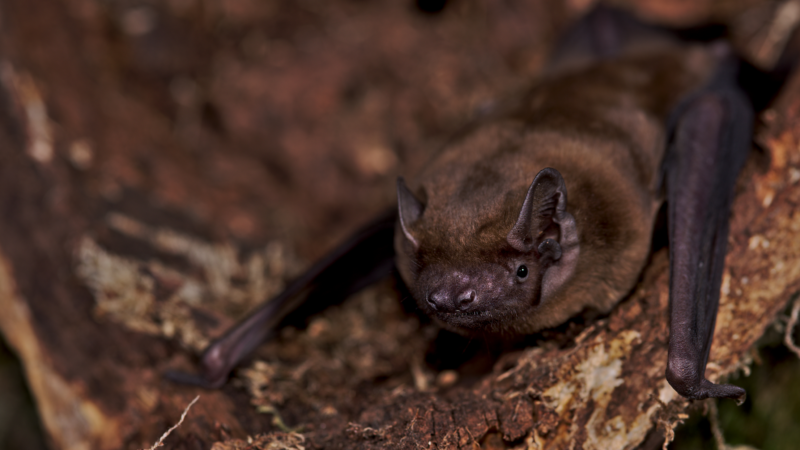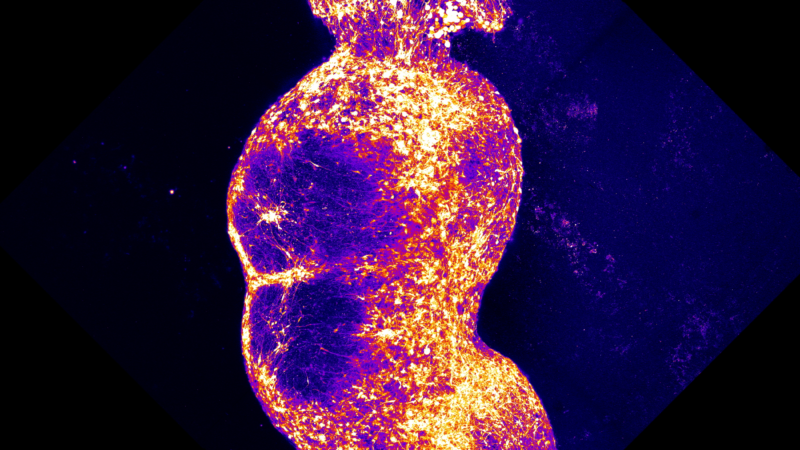Bats catch a lift from storm winds on long-distance migrations
Historically, bat migration has been a bit of a black box. While scientists have learned lots about how birds migrate, the handful of bat species that make long-distance journeys have been tougher to study.
“They’re fast and they move at night,” says Edward Hurme, a biologist at the Max Planck Institute for Animal Behavior in Germany. “Once they disappear from an area, we don’t necessarily have the ability to figure out where they show up somewhere else.”
Bats are also smaller than many migrating birds, meaning the sort of tracking tags that researchers stick to birds are too heavy for bats.
“To have something that can remotely send data about an animal and be small enough for a bat is really hard to come by,” says Hurme.
So Hurme and his colleagues had to design one. They created specialized tags weighing just over a gram that measured how the animal is moving, as well as temperature. Unlike some other tags, which measure animal movements but must be retrieved by scientists to download the data, these new tags broadcast their information to a wireless network, similar to how a cell phone does. That allows the researchers to triangulate their position and follow the bats’ journey.
All told, the team equipped 71 female noctule bats with these sensors. In spring, females typically migrate from their hibernation spots around Switzerland and Germany towards the northeast, where they roost. When the researchers paired their tracking data with climate data, they noticed a curious connection.
“We found that a lot of bats are actually migrating before storms come through,” says Hurme. In the spring, storms are typically preceded by warm fronts that generate strong winds that usually blow in the right direction for migration. That translates into significant energy savings for the bats, Hurme says, which can migrate nearly 1000 miles.
It turns out, these noctule bats time their springtime departure to coincide with warm fronts that precede storms, Hurme and colleagues reported this week in the journal Science. These winds tend to blow in the general northeasterly direction of the bats migration this time of year, giving the bats — which weigh about an ounce — a significant lift.
“This was actually a big surprise. We had some clue that bats were responding to good wind conditions, but we didn’t think that there was this connection to storms,” Hurme says.
“Sometimes they can ride it for one or two nights, but usually the storm keeps moving during the day. So while the bats are sleeping, the storm keeps going. And then they have to wait for the next good opportunity to migrate,” says Hurme.
There’s a cost to waiting too long, however. Many of these females are pregnant, and the longer they wait, the heavier they’ll be. Plus, the winds can always change.
“At the end of last year, the last bat to migrate was a week later than everyone else,” says Hurme. “But the wind direction totally changed to be blowing south, and so it finally just gave up and migrated against the winds.”
The researchers have yet to find out what cues the bats are using to time their departures. More broadly, Hurme hopes that more research groups start using the tiny bat tags on other bat species.
“We’re working with colleagues from Spain to the Czech Republic and trying to fill in the gaps of what bats are doing across the whole region as they fly north in the spring and come back south in the fall.”
Ultimately, that sort of work could help conserve bats. Collisions with wind turbines, for instance, kill a lot of bats. Understanding when and where they migrate could help researchers construct bat migration forecasts, which could help energy companies turn off turbines during migration, or avoid building in certain areas altogether, he says.
“We have a long way to go, but hopefully we can start moving towards a better system of being able to predict exactly when and where bats should be migrating.”
Transcript:
MARY LOUISE KELLY, HOST:
Animals burn a lot of energy during long-distance migrations. New research in the journal Science suggests that some bats make their journeys a bit easier by getting a lift. NPR’s Jonathan Lambert has more.
JONATHAN LAMBERT, BYLINE: Bat migration is a bit of a black box. Unlike many birds and other migratory species, bats only fly under cover of darkness. And that’s made them harder to study, says biologist Edward Hurme.
EDWARD HURME: So they’re fast, and they move at night. And once they disappear from an area, we don’t necessarily have the ability to figure out where they show up somewhere else.
LAMBERT: To overcome these challenges, they needed a way to track the bats. While GPS tags have helped researchers follow bird migration, bats are pretty small, so traditional tags don’t quite work.
HURME: To have something that can remotely send data about an animal and be small enough for a bat is really hard to come by.
LAMBERT: So Hurme and his colleagues at the Max Planck Institute of Animal Behavior in Germany, got creative. They study a species called the noctule bat that migrates across Central Europe, traveling northeast from around Switzerland towards Poland in the spring. To track their migration, they designed special tags small enough to fit on the bat’s back, sort of like a little backpack.
HURME: So the tags are really cool. They have multiple sensors on them, so they can record temperature and acceleration. And they don’t actually have a GPS on them at all.
LAMBERT: Instead, the tag connects to a wireless network, sort of like how a cell phone does. That allows the researchers to track their migrations in unprecedented detail. They followed over 70 bats and got some pretty surprising results.
HURME: We found that a lot of bats are actually migrating before storms come through. And this will generate some strong winds that are typically blowing in the right direction for migration. And bats typically try to ride this storm front.
LAMBERT: In other words, the bats are timing their departure to leave just before a storm comes through. Deciding to leave right when these winds arrive can save bats a lot of energy on their journeys, which can span nearly a thousand miles.
HURME: So sometimes they can ride it for one or two nights. But usually the storm keeps moving during the day, and so while the bats are sleeping, the storm keeps going. And then they have to wait for the next good opportunity to migrate.
LAMBERT: Waiting too long for the perfect winds has a cost too. Female noctule bats are usually pregnant this time of year. And the longer they wait, the heavier their little bat bun in the oven will be, which could weigh them down.
HURME: It’s kind of a gamble when and where to migrate.
LAMBERT: But more fully understanding the bats’ journeys could ultimately help their conservation. Wind turbines, for instance, can kill a lot of bats. And Hurme hopes this work might help researchers develop migration forecasts that energy companies could use to minimize harm to these nighttime fliers.
Jonathan Lambert, NPR News.
(SOUNDBITE OF DANIEL CAESAR SONG, “DO YOU LIKE ME”)
Healing soup recipes, Part 2: Definitely not your grandma’s chicken soup!
The second installment of our soup-a-thon. Vicky Hallett and Genevieve Villamora, correspondents. Marc Silver, digital editor. Radio interview ran last week. Digital publishing Thursday at 7 a.m.
‘The Amateur’ and 3 more buzzy movies in theaters this weekend
Rami Malek plays a CIA data analyst out of his depth in The Amateur, while Warfare depicts a real-life Iraqi mission, calibrated as a cinematic show-of-force.
Pain pathway in a dish could aid search for new analgesic drugs
Scientists have recreated a pathway that senses pain, using clusters of human nerve cells grown in a dish.
Asia markets soar, after President Trump pauses global tariffs
Asia markets followed Wall Street's gains after Trump announced a pause on higher global tariffs, but investors are still looking to Beijing for reaction.
‘Black Mirror’ creator pulls from reality in dystopian season 7, out now
Black Mirror season 7 is out now on Netflix. Charlie Brooker, the show's creator, says he's "worrying in what I hope is an entertaining way" in an interview with NPR's A Martínez.
As measles spreads, federal budget cuts force closure of vaccine clinics
Federal funding cuts, though temporarily blocked by a judge, have upended vaccination outreach across the country, including in Arizona, Minnesota, Nevada, Texas, and Washington state.








